What is hydroponics?
What is hydroponics?
Hydroponics according to growshops.fr, your online horticultural advisor.
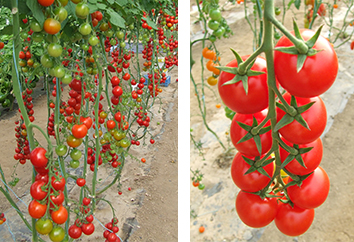 |
... |
Having for Greek meaning water work (hydro = water and ponos = work), hydroponics is a modern and efficient growing method, more and more popular throughout the world. Previously used exclusively by the agri-food industry, hydroponics is now widely used by individuals for domestic use. Generally speaking, hydroponics is based on an irrigation system, designed to automatically and uniformly distribute the nutrient solution to the plants. Qualified as soilless culture, hydroponics relies on a base of inert substrates, containing no nutrients, in which the roots of the plants evolve, and on which an adapted, evolving and controlled fertilization is brought, usingEC and pH testers. |
Find all the hydroponics and complete systems dedicated to soilless culture, at the best prices on the web on your favorite site, growshops.fr.
With European brands with a well established reputation, such as General Hydroponics (GHE), Platinium Hydroponics, Nutriculture LTD, HydroSystem, AutoPot Global, Alien Hydroponics Systems, PI Technics, IWS Systems, AeroGarden,...
What is the most common hydroponic configuration?
In most cases, hydroponics takes the form of a horticultural system, equipped with a pump, water or air, which itself feeds a closed irrigation circuit.
Also known as ebb and flow, this basic version of hydroponics involves recycling the nutrient solution, i.e., it circulates and is re-injected multiple times to the plants.
Contained in their hydroponic substrates, hydroponic plants are usually placed on a growing table, called a tray, which itself rests on a reservoir designed to hold the nutrient solution.
In hydroponics, the automatic fertilization is controlled by a mechanical or electronic programmer, to cycle its contributions and thus gradually meet the needs of the plants, according to the stage of culture.
Made necessarily homogeneous, this same irrigation is produced by means of irrigation stakes or by flooding, on the models of tidal tables that are the Ebb and Flow of Platinium Hydroponicsor the Ebb and Flood of Nutriculture LTD.
| Drip system | Aeroponic system | Tide table system | NFT system |
| Irrigation by stakes |
Spray irrigation |
Irrigation by flooding |
Irrigation by runoff |
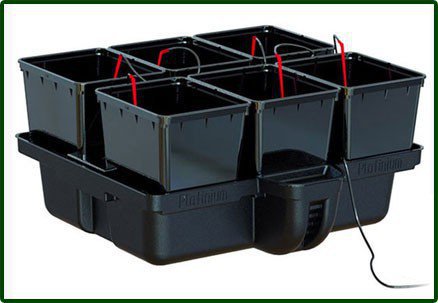 |
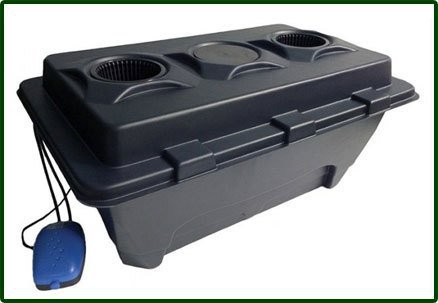 |
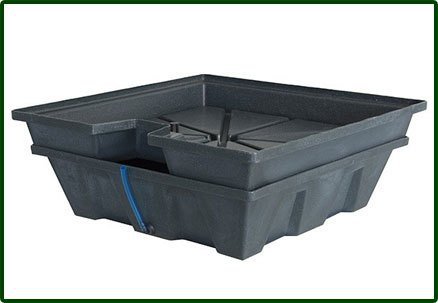 |
 |
Why is hydroponics a popular growing method in urban areas?
Contrary to popular belief, hydroponics is an innovative way of growing plants that is accessible to everyone, without the need for any horticultural degree, and is fully dedicated to indoor growing.
Even in the city, hydroponics offers to all households the optimized development of ornamental plants and access toself-production of fruits, vegetables, aromatic herbs... All year long, without worrying about external weather conditions!
Given the impressive productivity generated by this method of cultivation, hydroponics also leads to a gain in surface area and easier maintenance than traditional soil-based cultivation.
In addition, hydroponics is an autonomous and practical horticultural method, since the plants are self-fed by an irrigation system and the nutrient solution is changed every 7 to 10 days.
If you want to grow with the hydroponic method at home, Growshops.fr offers you these pages of advice to prepare you well:
And find all our advice sheets right here!
What does a hydroponic system consist of?
In a hydroponic system, the nutrient solution must be water soluble, storable and therefore of mineral origin.
The nutrient solution is stored in a separate tank, covered of course, to avoid any proliferation of algae or pathogenic bacteria.
Placed in an inert, sterile substrate , the plants are placed on a table or a culture tray, also serving as a receptacle for the drain (the solution flowing out of the pots).
This recovery tray also allows the return of the nutrient solution to the reservoir to be channeled and then reinjected at will.
Another important point of a hydroponic system is theautomated irrigation.
Whether driven by pumps or not, the installation of an adapted irrigation remains an essential element in the constitution of a hydroponic system.
In addition, only if this irrigation is based on a water or air pump, the acquisition of a programmer (mechanical or electronic) is more or less essential to cycle the automatic watering and thus avoid saturating the substrate in which the roots of the plants grow.
What are the two major irrigation modes, visible on a hydroponic medium?
To simplify, there are two types of irrigation among the hydroponic systems distributed on the European market: active and passive.
In fact, the irrigation of a hydroponic medium ensures the homogeneous distribution of the nutritive solution and meets the needs of your plants.
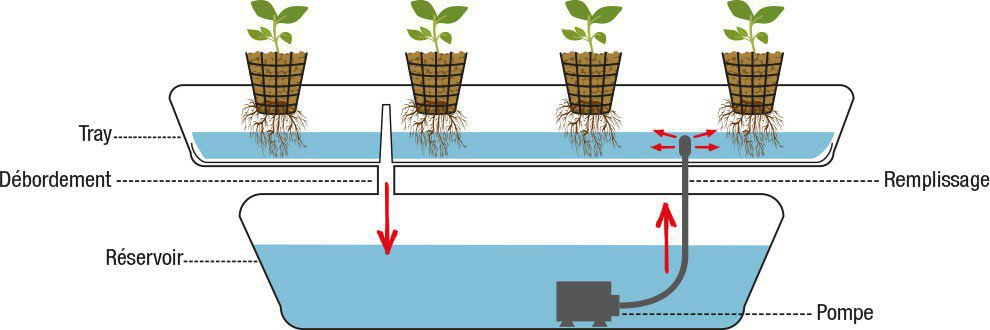 |
.... |
< Active system In hydroponics, both in their duration and their daily repetitions, the irrigation cycles must take into account the substrate used and especially its water and nutrient retention capacity. |
|
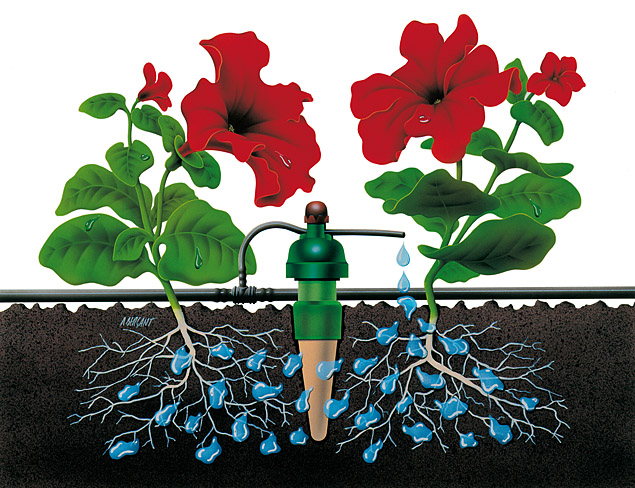 |
.... |
< Passive system Mixing the principles of gravity and capillarity, the irrigation of some hydroponic systems can be passive, with brands like Blumat or Autopot Global. |
We can also distinguish two types of hydroponic systems: open circuits and closed circuits.
Growshops.fr does not advise the open circuit which is not very ecological or economical. Indeed it will be necessary to provide a place for the water to drain, but you will then lose your nutrient solution ...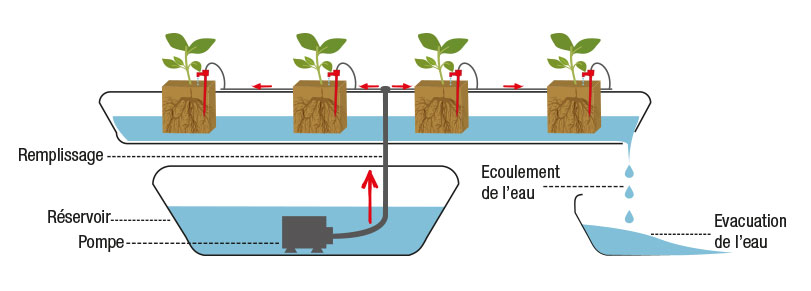
On the contrary, Growshops.fr advises you the closed circuit, more economical and more ecological thanks to the recycling of the nutritive solution. On the other hand, you will have to check your solution regularly so that your plants are always happy with it! Moreover the closed circuits are perfectly adapted to the indoor culture.
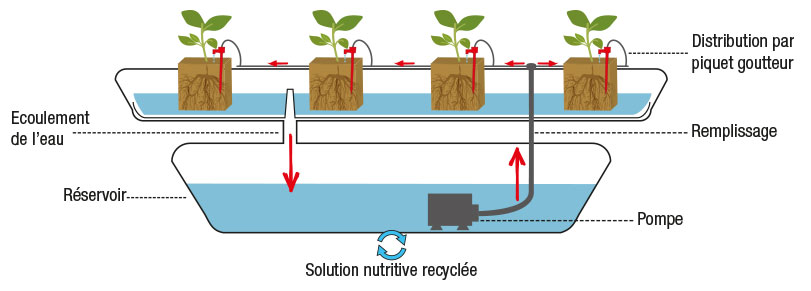
Finally, the reservoir is used to store and recover the nutritive solution, and can be placed underneath or, more rarely, deported nearby, such as the specific hydroponic systems developed by AutoPot Global, Alien Hydroponics Systems or IWS Systems.
growshops.fr, your online horticultural advisor.
